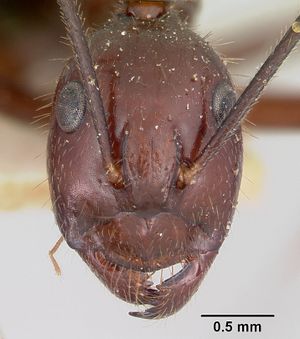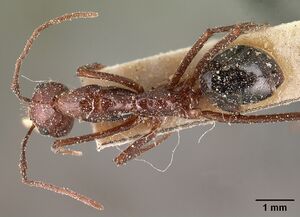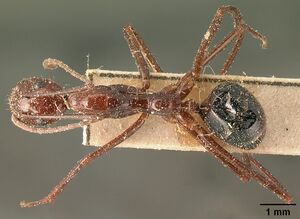Camponotus imitator
| Camponotus imitator | |
|---|---|

| |
| Scientific classification | |
| Kingdom: | Animalia |
| Phylum: | Arthropoda |
| Class: | Insecta |
| Order: | Hymenoptera |
| Family: | Formicidae |
| Subfamily: | Formicinae |
| Tribe: | Camponotini |
| Genus: | Camponotus |
| Subgenus: | Myrmosaga |
| Species: | C. imitator |
| Binomial name | |
| Camponotus imitator Forel, 1891 | |
| Synonyms | |
| |
Camponotus imitator has been collected by litter sifting, Malaise and pitfall traps, as well as beating low vegetation and from the ground in rotten logs. It nests underground. The minor worker of Camponotus imitator is thought to mimic the myrmicine ant Aphaenogaster swammerdami due to its color and the form of its constricted mesonotum and shape of propodeum, which could appear as a petiole in dorsal view. The distribution of C. imitator is sympatric with A. swammerdami through most of its range. (Rasoamanana et al., 2017)
Identification
Rakotonirina & Fisher (2022) - With head in full-face view, posterior portion of head extending into a neck, and anteromedian clypeal margin continuously forming broad convexity; dorsal outline of mesosoma complex; body color black to dark brown.
Camponotus imitator can be easily separated from the other species of the Myrmosaga group in that it is the only species that is characterized by an elongate mesonotum that is constricted at midlength, and its propodeum is broadly convex when the mesosoma is viewed in profile.
Rasoamanana et al. (2017) - Camponotus imitator is easily recognizable within Myrmopytia (= Myrmosaga) on the basis of the following combination of characters: posterior region of head only slightly extended, not narrowed into a long neck in the minor worker, PoOC/CL 0.256 [0.224, 0.304] and trapezoidal in major worker, CWb/CL 0.951 [0.841, 1.031]; anterior clypeal margin with a rectangular projection ClyL/CL 0.289 [0.231, 0.316]; petiole nodiform PEW/CS 0.224 [0.203, 0.255]; both castes bicolored: head, mesosoma and appendages reddish brown to dark brown, gaster black (minor) to mainly black (major).
Keys including this Species
- Key to Camponotus Myrmopytia workers
- Key to minor workers of the Malagasy Camponotus, subgenus Myrmosaga
Distribution
Dry forest and woodland of western and southern Madagascar at elevations ranging from 25 m to 990 m.
Latitudinal Distribution Pattern
Latitudinal Range: -16.31667° to -25.58167°.
| North Temperate |
North Subtropical |
Tropical | South Subtropical |
South Temperate |
- Source: AntMaps
Distribution based on Regional Taxon Lists
Malagasy Region: Madagascar (type locality).
Distribution based on AntMaps
Distribution based on AntWeb specimens
Check data from AntWeb
Countries Occupied
| Number of countries occupied by this species based on AntWiki Regional Taxon Lists. In general, fewer countries occupied indicates a narrower range, while more countries indicates a more widespread species. |

|
Estimated Abundance
| Relative abundance based on number of AntMaps records per species (this species within the purple bar). Fewer records (to the left) indicates a less abundant/encountered species while more records (to the right) indicates more abundant/encountered species. |

|
Biology
Mimicry
Within Madagascar, there are four species of Camponotus, Camponotus imitator, Camponotus jodina, Camponotus karaha and Camponotus longicollis, that mimic the general form and behavior of the Aphaenogaster swammerdami group, specifically Aphaenogaster bressleri, Aphaenogaster gonacantha, Aphaenogaster makay, Aphaenogaster sahafina and Aphaenogaster swammerdami. These Camponotus mimics are often seen foraging with workers of Aphaenogaster, but potential benefits for Camponotus have not been studied (Csosz et al., 2021).
Castes
Worker
Images from AntWeb
   
| |
| Lectotype of Camponotus imitator. Worker. Specimen code casent0101365. Photographer April Nobile, uploaded by California Academy of Sciences. | Owned by MHNG, Geneva, Switzerland. |
   
| |
| Paralectotype of Camponotus imitator. Worker. Specimen code casent0104647. Photographer April Nobile, uploaded by California Academy of Sciences. | Owned by ZMHB, Berlin, Germany. |
   
| |
| Lectotype of Camponotus imitator resinicola. Worker. Specimen code casent0101117. Photographer April Nobile, uploaded by California Academy of Sciences. | Owned by NHMB, Basel, Switzerland. |
   
| |
| Paralectotype of Camponotus imitator resinicola. Worker. Specimen code casent0101118. Photographer April Nobile, uploaded by California Academy of Sciences. | Owned by NHMB, Basel, Switzerland. |
   
| |
| Paralectotype of Camponotus imitator. Worker. Specimen code casent0101119. Photographer April Nobile, uploaded by California Academy of Sciences. | Owned by NHMB, Basel, Switzerland. |
Nomenclature
The following information is derived from Barry Bolton's Online Catalogue of the Ants of the World.
- imitator. Camponotus imitator Forel, 1891b: 209, pl. 4, fig. 15; pl. 5, fig. 8 (w.) MADAGASCAR.
- Type-material: lectotype minor worker (by designation of Rasoamanana, et al. 2017: 133), 2 paralectotype minor workers.
- Type-locality: lectotype Madagascar: Morondava (W coast of Madagascar) (C. Grevé); paralectotypes with same data.
- [Notes (i): other original syntype localities: Tullear (SW coast of Madagascar) (C. Grevé), and same localities (Morondava, Tullear) (A. Grandidier) (invalid restriction of type-locality to Tullear by Wheeler, W.M. 1922a: 1048; no lectotype designated).]
- Type-depositories: MHNG (lectotype); MHNG, MNHU, NHMB (paralectotypes).
- Combination in C. (Myrmosphincta): Forel, 1912i: 92;
- combination in C. (Myrmopytia): Emery, 1920b: 257;
- combination in C. (Myrmosaga): Rakotonirina & Fisher, 2022: 110.
- Status as species: Dalla Torre, 1893: 235; Emery, 1896d: 374 (in list); Forel, 1907g: 92; Wheeler, W.M. 1922a: 1048; Emery, 1925b: 115; Bolton, 1995b: 104; Rasoamanana, et al. 2017: 133 (redescription); Rakotonirina & Fisher, 2022: 110.
- Senior synonym of resinicola: Rasoamanana, et al. 2017: 133.
- Distribution: Madagascar.
- resinicola. Camponotus imitator var. resinicola Santschi, 1911e: 133 (s.w.) MADAGASCAR.
- Type-material: lectotype worker (by designation of Rasoamanana, et al. 2017: 133), 1 paralectotype worker.
- Type-locality: lectotype Madagascar: Ambolisatra, 6.vii.1898 (G. Grandidier); paralectotype Madagascar: Androhomana, xi.1901 (Ch. Alluaud).(invalid restriction of type-locality by Wheeler, W.M. 1922a: 1049; no lectotype designated).
- Type-depository: NHMB (perhaps also MNHN).
- Combination in C. (Myrmopytia): Wheeler, W.M. 1922a: 1049; Emery, 1925b: 115.
- Status as species: Wheeler, W.M. 1922a: 1049.
- Subspecies of imitator: Emery, 1925b: 115; Bolton, 1995b: 120.
- Junior synonym of imitator: Rasoamanana, et al. 2017: 133.
Unless otherwise noted the text for the remainder of this section is reported from the publication that includes the original description.
Description
Worker
Rakotonirina and Fisher (2022) - Morphological measurements: see Appendix 1 and Morphological measurements: see Appendix 1 and Ratios of morphometric data for majors and minors
Rasoamanana et al. (2007) - Minor Head suboval, posterior region of head only slightly and broadly extended with margins weakly convex. (CS) 1.68 mm [1.34, 2.18] (n=25). Standing setae present on posterolateral margin of head and vertex in full-face view. Eyes situated on posterior half of head, PoOC/CL 0.253 [0.224, 0.293]. Frontal carina convex, FR/CS 0.254 [0.209, 0.280], antennal scape surpassing posterior margin of head by more than half its length, SL/CS 1.517 [1.211, 1.731]. Anteromargin of clypeus with broad rectangular projection, posterior margin concave, ClyL/CL 0.271 [0.231, 0.293]; mandible with six teeth, palps long with respect to head size.
Pronotum weakly undulant. Suberect pronotal setae numerous (more than 12). Mesonotum straight, MPD/CS 1.181 [0.954, 1.403]. Erect mesonotal setae varying from absent to numerous (two or three pairs anterior to mesothoracic spiracle). Mesothoracic spiracles prominent; propodeal dorsum protuberant. Erect propodeal setae moderate in number (4–6). ML/CS 1.957 [1.670, 2.149]. Petiole nodiform, dorsum of node convex, petiole higher than broad, PEW/CS 0.242 [0.164, 0.264]. Erect setae present on petiolar apex.
Color: head and mesosoma red to reddish brown, gaster dark brown to black. Erect setae light brown. Sparse appressed pubescence present.
Major In full-face view, head truncated posteriorly, evenly tapering to base of mandibles, posterior margin of head weakly concave. Absolute cephalic size (CS) 3.26 mm [2.32, 3.94] (n=22). Cephalic margin with scattered short hairs; cephalic dorsum coarsely reticulate-foveolate. Eye situated on posterior half of the head, PoOC/CL 0.284 [0.242, 0.323]. Frontal carinae sinuate, FR/CS 0.260 [0.209, 0.280], coronal line distinct, antennal scape just surpassing the posterior margin of head by length of one funiculus segment, SL/CS 0.853 [0.711, 1.155]. Anterior margin of clypeus with a rectangular projection, medially straight to slightly convex, ClyL/CL 0.294 [0.269, 0.326]; masticatory margin of mandible with 7–10 teeth, microreticulate at base, becoming finely striolate apically, with scattered piligerous punctures, rarely with a few weak longitudinal rugae near base.
Dorsal outline of mesosoma complex. Promesonotum forms a regular convexity with a shallow impression at the promesonotal suture and is stepped to the propodeal dorsum. Suberect promesonotal setae inclined anteriorly, ML/CS 1.337 [1.168, 1.655]; metanotum distinct; propodeal dorsum almost straight to evenly convex, posterodorsal margin forms rounded angle with declivity.
Petiole higher than broad, node summit flat; brown standing setae present on entire dorsum. PEW/CS 0.221 [0.199, 0.247].
Color: head, mesosoma, petiole, and base of first gastral segment reddish brown, remainder of gaster dark brown to black. Scattered appressed pubescence generally present. Setae light brown.
Type Material
- Camponotus imitator: Lectotype (designated by Rasoamanana et al., 2017: 133), worker, Province Toliara, Morandava, Madagascar, 20°17′00″S 44°17′00″E / 20.2833°S 44.28333°E, Grevé, CASENT0101365, Musee d'Histoire Naturelle Genève.
- Camponotus imitator: Paralectotype (designated by Rasoamanana et al., 2017: 133), 1 worker, Province Toliara, Morandava, Madagascar, 20°17′00″S 44°17′00″E / 20.2833°S 44.28333°E, Grevé, CASENT0101116, Naturhistorisches Museum, Basel.
- Camponotus imitator: Paralectotype (designated by Rasoamanana et al., 2017: 133), 1 worker, Province Toliara, Morandava, Madagascar, 20°17′00″S 44°17′00″E / 20.2833°S 44.28333°E, Grevé, CASENT0104647, Berlin Museum für Naturkunde der Humboldt-Universität.
- Camponotus imitator resinicola: Lectotype (designated by Rasoamanana et al., 2017: 133), worker, Ambolisatra [probably today’s Ambolisaka], Madagascar, 21°44′00″S 43°22′00″E / 21.7333°S 43.36666°E, 6-7-1898, C. Grandidier, CASENT0101117, Naturhistorisches Museum, Basel.
- Camponotus imitator resinicola: Paralectotype (designated by Rasoamanana et al., 2017: 133), 1 worker, Region du Sud, Andrahomana, Madagascar, 25°11′00″S 46°38′00″E / 25.183333°S 46.63333°E, Nov. 1901, Ch. Alluaud, CASENT0101118, Naturhistorisches Museum, Basel.
- Camponotus imitator resinicola: Paralectotype (designated by Rasoamanana et al., 2017: 133), 1 worker, Region du Sud-Est, Fort-Dauphin, Madagascar, 25°02′00″S 46°59′00″E / 25.03333°S 46.98333°E, Août, 1901, Ch. Alluaud, CASENT0101119, Naturhistorisches Museum, Basel.
Taxonomic Notes
Rasoamanana et al. (2017) - We propose that Camponotus imitator resinicola (Santschi, 1911) is synonymized with Camponotus imitator Forel. In the original descriptions, the former differs from the latter by the presence of reddish patches on the first gastral segment near the petiolar insertion. Examination of material from 10 collection events of C. imitator colonies indicates that this trait is highly variable within colonies, and no other reliable characters were found to separate the subspecies from imitator. Moreover, no other qualitative trait or biogeographic evidence exists that would underpin the subspecies status of resinicola.
References
- Csősz, S., Loss, A.C., Fisher, B.L. 2021. Taxonomic revision of the Malagasy Aphaenogaster swammerdami group (Hymenoptera: Formicidae). PeerJ 9, e10900. (doi:10.7717/peerj.10900).
- Emery, C. 1920b. Le genre Camponotus Mayr. Nouvel essai de la subdivision en sous-genres. Rev. Zool. Afr. (Bruss.) 8: 229-260 (page 257, Combination in C. (Myrmopytia))
- Forel, A. 1891c. Les Formicides. [part]. In: Grandidier, A. Histoire physique, naturelle, et politique de Madagascar. Volume XX. Histoire naturelle des Hyménoptères. Deuxième partie (28e fascicule). Paris: Hachette et Cie, v + 237 pp. (page 209, pl. 4, fig. 15; pl. 5, fig. 8 worker described)
- Forel, A. 1912j. Formicides néotropiques. Part VI. 5me sous-famille Camponotinae Forel. Mém. Soc. Entomol. Belg. 20: 59-92 (page 92, Combination in C. (Myrmosphincta))
- Rakotonirina, J.C., Fisher, B.L. 2022. Revision of the Malagasy Camponotus subgenus Myrmosaga (Hymenoptera, Formicidae) using qualitative and quantitative morphology. ZooKeys 1098: 1–180 (doi:10.3897/zookeys.1098.73223).
- Rasoamanana, N., Csősz, S., Fisher, B.L. 2017. Taxonomic revision of imitating carpenter ants, Camponotus subgenus Myrmopytia (Hymenoptera, Formicidae) of Madagascar, using morphometry and qualitative traits. ZooKeys 681: 119–152 (DOI 10.3897/zookeys.681.13187).
- Wheeler, W. M. 1922k. Ants of the American Museum Congo expedition. A contribution to the myrmecology of Africa. IX. A synonymic list of the ants of the Malagasy region. Bull. Am. Mus. Nat. Hist. 4 45: 1005-1055 (see also)
References based on Global Ant Biodiversity Informatics
- Fisher B. L. 1997. Biogeography and ecology of the ant fauna of Madagascar (Hymenoptera: Formicidae). Journal of Natural History 31: 269-302.
- Fisher B. L. 2003. Formicidae, ants. Pp. 811-819 in: Goodman, S. M.; Benstead, J. P. (eds.) 2003. The natural history of Madagascar. Chicago: University of Chicago Press, xxi + 1709 pp.
- Ravelomanana A., and B. L. Fisher. 2013. Diversity of ants in burned and unburned grassland , and dry deciduous forest in the Beanka Reserve, Melaky Region, western Madagascar. Malagasy Nature 7: 171-183.
- Wheeler W. M. 1922. Ants of the American Museum Congo expedition. A contribution to the myrmecology of Africa. IX. A synonymic list of the ants of the Malagasy region. Bulletin of the American Museum of Natural History 45: 1005-1055

